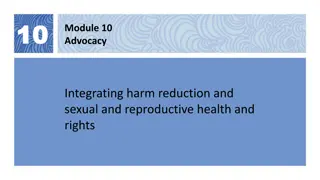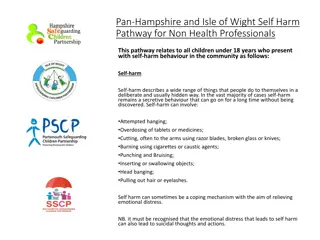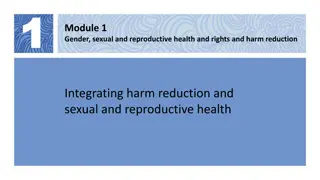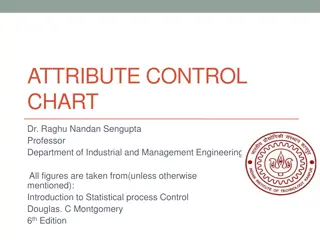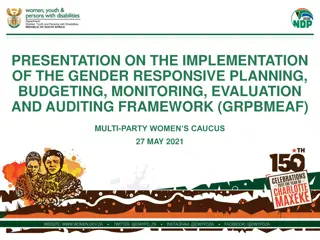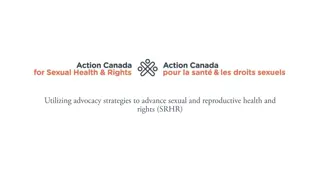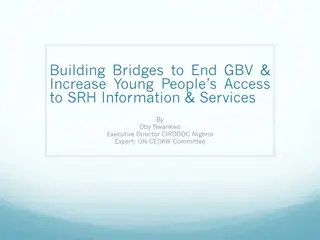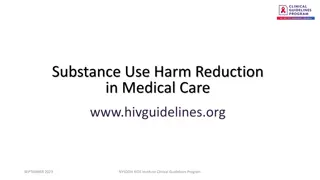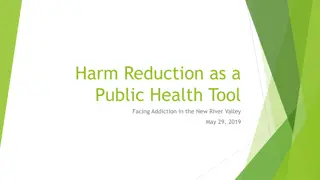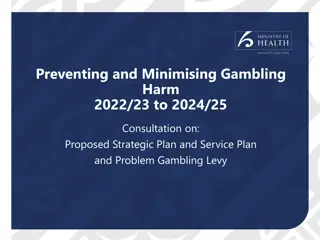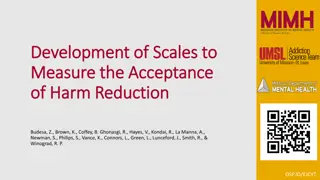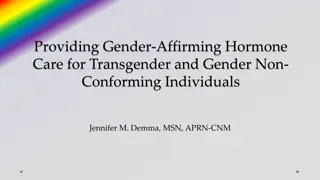Integrating Harm Reduction and SRHR Services for Women and Gender Non-Conforming People Who Use Drugs
This module focuses on integrating harm reduction and sexual and reproductive health and rights (SRHR) services for women and gender non-conforming individuals who use drugs. It aims to identify gaps in service provision, map appropriate client-oriented SRHR services, and develop action plans to improve access and integration. Brainstorming sessions explore the characteristics of harm reduction programs, centers, and providers tailored to the needs of this specific population. The programmatic features emphasize community involvement, peer support, comprehensive service provision, and advocacy led by affected communities.
Download Presentation

Please find below an Image/Link to download the presentation.
The content on the website is provided AS IS for your information and personal use only. It may not be sold, licensed, or shared on other websites without obtaining consent from the author. Download presentation by click this link. If you encounter any issues during the download, it is possible that the publisher has removed the file from their server.
E N D
Presentation Transcript
9 9 Module 9 Integration of SRHR services Integrating harm reduction and sexual and reproductive health and rights
Module 9 Integration of SRHR services LEARNING OBJECTIVES 2 hours 20 minutes To identify gaps in the provision of essential SRHR services in organisations providing harm reduction services To map appropriate services that offer client-oriented, non- judgmental SRHR services for women and gender non-conforming people who use drugs To develop short-term and mid-term action plan to improve the access to and integration of SRHR and harm reduction services
Module 9 Integration of SRHR services BRAINSTORMING: 10 minutes In your opinion, what are the characteristics of a harm reduction programme designed for women and gender non-conforming people who use drugs? In your opinion, what are the characteristics of a harm reduction centre/DIC that is adapted to the needs, including the SRHR needs, of women and gender non- conforming people in terms of facilities and services? In your opinion, what are the characteristics of providers working in a programme/centre adapted to the needs of women and gender non-conforming people who use drugs?
Module 9 Integration of SRHR services PROGRAMMATIC FEATURES Supporting the meaningful involvement of the women in all their diversity and gender non- conforming people who use drugs in the design, planning, implementation, monitoring and evaluation of programmes Provision of both individual and group activities Provision of services in a centre and through outreach to reach those most at risk Involvement of trained peers and/or recruit peer staff and peer managers Involvement of partners, friend and relatives Strong referral network Intervention at all levels, including interventions at community level, and empowering female and gender non-conforming communities Advocacy strategy led by women and gender non-conforming people who use drugs, and supporting the skills and structure of community networks.
Module 9 Integration of SRHR services PROVIDERS Staff trained on SRHR, gender norms and gender equity, and are respectful with trans-women, sex workers etc. Integration and recognition of the value of peers (at different positions, including as leaders) Respect of ethics principles (confidentiality, privacy, informed consent, respect of individual choice, non-judgmental, no discrimination, etc.) Client-oriented approach and adequate time is given to client/provider interaction
Module 9 Integration of SRHR services DEVELOPING AND STRENGTHENING COLLECTIVES OF WOMEN AND GENDER NON- CONFORMING PEOPLE WHO USE DRUGS Many of the best programmes have been started and are led by women and gender non-conforming people who use drugs. Support mobilising these community groups by: Offering spaces to meet Providing discreet advertising to other women/ gender non-conforming people with similar interests Proposing organisational and methodological support Providing resources for peer education Providing up-to-date information on relevant research Proposing stakeholder linkages Support with funding and training opportunities To overcome potential barriers, such as difficulties in accessing or identifying these communities or when community networks are not yet established, it is essential to recruit women/gender non-conforming people who use drugs as volunteers, paid staff and managers.
Module 9 Integration of SRHR services EVALUATION OF SERVICES: 25 minutes Working in 3 groups Step 1 : Tick the appropriate boxes checklist Step 2: Give a score of 1 for every yes answer and 0 for every no Step 3 : Prioritise 3 areas
Module 9 Integration of SRHR services THE 4A EVALUATION: 20 minutes Accessibility Acceptability Availability Affordability
Module 9 Integration of SRHR services MAPPING: 20 minutes Working in 3 groups Based on the the previous mapping done, develop this comprehensive mapping: First circle: existing referral system Second circle: existing services not used by the women/gender non- conforming people who use drugs for potential new referral pathway
Module 9 Integration of SRHR services DEVELOP ACTION PLANS: 40 minutes








